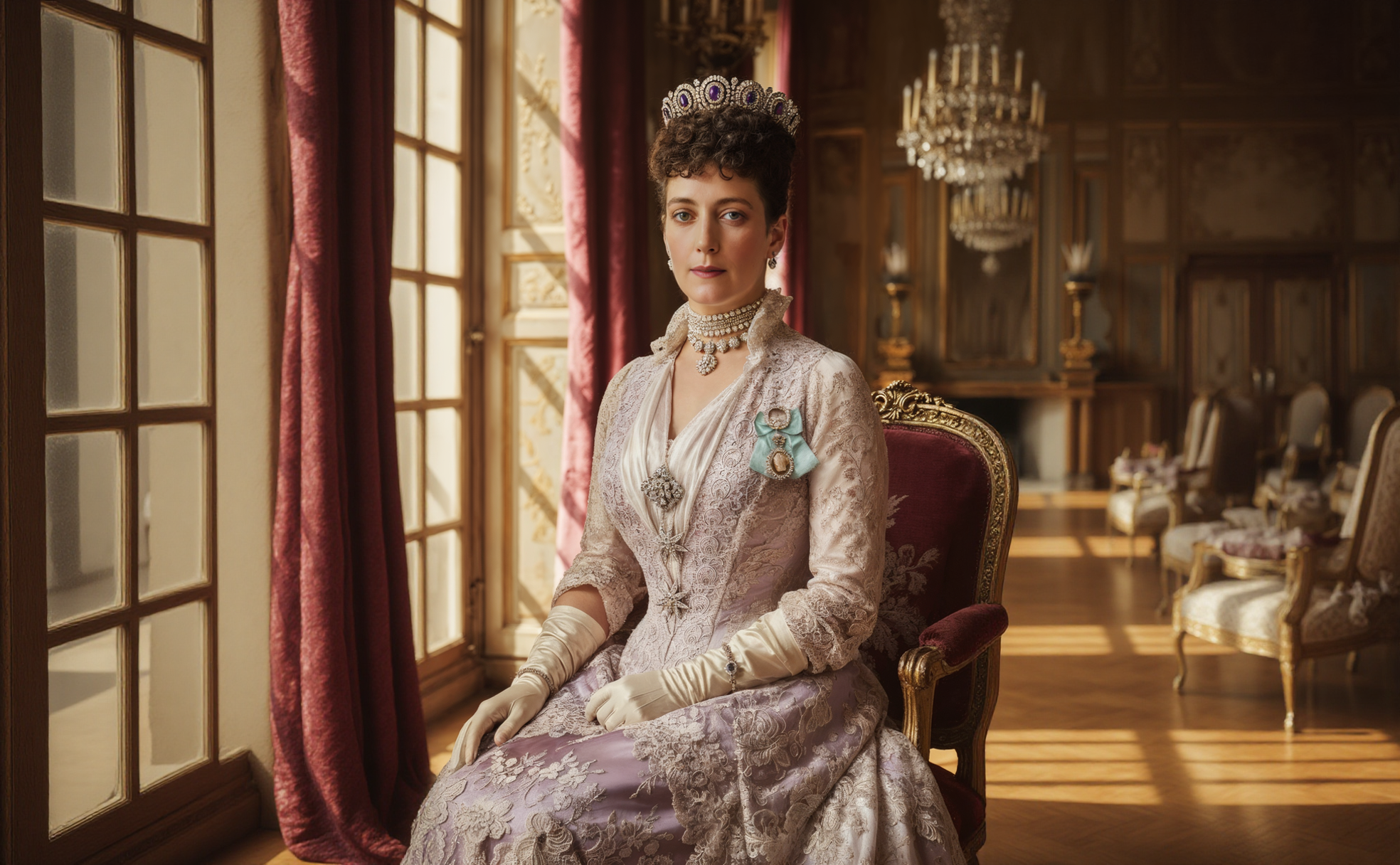เทียร่าอะเมทิสต์ “ลึกลับ” ของสมเด็จพระราชินีอเล็กซานดรา
เทียร่าอะเมทิสต์ “ลึกลับ” ของสมเด็จพระราชินีอเล็กซานดรา
การฟื้นชีวิตใหม่ให้กับอัญมณีที่สูญหายและความเข้าใจผิดที่แพร่หลายในประวัติศาสตร์ ของ Amethyst Tiara หรือ “เทียร่าพลอยอเมทิสต์" ซึ่งเป็นเทียร่าประดับด้วยพลอยสีม่วง ล้อมด้วยเพรช ของสมเด็จพระราชินีอเล็กซานดรา
เทียร่าอะเมทิสต์และเพชรที่มักถูกระบุว่าเป็นของ สมเด็จพระราชินีอเล็กซานดราแห่งสหราชอาณาจักร (ค.ศ. 1844–1925) นับเป็นหนึ่งในอัญมณีที่ถูกเข้าใจผิดมากที่สุดในประวัติศาสตร์ราชสำนักยุโรป ภาพที่เผยแพร่กันอย่างกว้างขวางบนโลกออนไลน์มักแสดงให้เห็น เทียร่าคาร์เทียร์ ซึ่งจัดแสดงอยู่ที่ พิพิธภัณฑ์มูเซโอ เดลลี อาร์เจนติ (Museo degli Argenti) ณ เมืองฟลอเรนซ์ ทว่าเทียร่าชิ้นนั้นมีลักษณะแตกต่างอย่างสิ้นเชิงจากเทียร่าของสมเด็จพระราชินีและภายหลังพระองค์พระราชทานแด่พระราชธิดา
เทียร่าอะเมทิสต์ของสมเด็จพระราชินีอเล็กซานดรา ที่แท้จริงนั้น ปรากฏคำบรรยายไว้ในแค็ตตาล็อกการประมูลของ คริสตีส์ (Christie’s) เมื่อปี ค.ศ. 1946 ว่า “ประกอบด้วยอะเมทิสต์ทรงรีเจ็ดเม็ดเรียงลดหลั่นจากกึ่งกลาง ประดับด้วยลายดอกไม้เพชรและใบไม้คู่ รองรับด้วยฐานเพชรเรียงเส้น” เทียร่าพระองค์นี้เป็นของขวัญจาก พระเจ้าซาร์อเล็กซานเดอร์ที่ 3 แห่งรัสเซีย พระเชษฐาในสมเด็จพระราชินีมารี ฟีโอโดรอฟนา พระราชินีแห่งรัสเซีย พระราชธิดาองค์ใหญ่ของสมเด็จพระราชินีอเล็กซานดรา ผู้ที่ทรงได้ครอบครองไว้ คือ เจ้าหญิงลูอีส ดัชเชสแห่งไฟฟ์ ก่อนจะสืบทอดต่อให้แก่ เลดี้มอด เคาน์เตสแห่งเซาธ์เอสก์ หลังจากเลดี้มอดสิ้นชีพในปี ค.ศ. 1945 เครื่องเพชรทั้งหมดได้ถูกนำออกประมูลที่ลอนดอน เทียร่าองค์นี้ถูกประมูลไปในราคา 1,750 ปอนด์และไม่เคยปรากฏต่อสาธารณชนอีกเลยจนถึงปัจจุบัน
ส่วนเทียร่าคาร์เทียร์ที่เมืองฟลอเรนซ์ ซึ่งมักถูกเข้าใจผิดว่าเป็นของสมเด็จพระราชินีอเล็กซานดรา สร้างสรรค์ขึ้นในราวปี ค.ศ. 1900 ตัวเทียร่าประกอบด้วย อะเมทิสต์ทรงหยดน้ำ (pear-shaped) ประดับในลวดลายใบกระวานและเพชรโดยรอบ ทั้งยังไม่มีฐานเพชรเรียงเส้นอย่างที่ระบุไว้ในบันทึกของคริสตีส์ ดังนั้นเทียร่าทั้งสององค์จึงมิใช่เทียร่าเดียวกัน ความคล้ายคลึงที่เห็นจึงเป็นเพียงผิวเผินเท่านั้น ความสับสนนี้น่าจะเกิดจากการที่ภาพถ่ายที่ชัดเจนของเทียร่าองค์จริงไม่เคยปรากฎ หลังจากการประมูล ทำให้นักเขียนและภัณฑารักษ์รุ่นหลังเลือกใช้เทียร่าคาร์เทียร์ที่สามารถเข้าถึงได้มากกว่าเป็นภาพประกอบแทน
พระฉายาลักษณ์ของสมเด็จพระราชินีอเล็กซานดรา ซึ่งได้รับการบูรณะและสร้างสรรค์ขึ้นใหม่ด้วยเทคโนโลยี AI ถ่ายทอดภาพและรูปภัณฑ์ของ เทียร่าอะเมทิสต์ที่สูญหายไป ได้อย่างสมจริง โดยอ้างอิงจากพระฉายาลักษณ์ที่ถ่ายโดย สตูดิโอ W. & D. Downey ซึ่งเป็นช่างภาพประจำราชสำนักอังกฤษ และยังเป็นสตูดิโอเดียวกันที่ พระบาทสมเด็จพระจุลจอมเกล้าเจ้าอยู่หัว เคยเสด็จฯ ไปทรงฉายพระบรมฉายาลักษณ์เมื่อครั้งเสด็จประพาสอังกฤษอีกด้วย
ภาพนี้เผยให้เห็นอิทธิพลทางแฟชั่นของสมเด็จพระราชินีอเล็กซานดราได้อย่างเด่นชัด — ทั้ง คอเสื้อลูกไม้สูง และ สร้อยคอเพชรแบบโชกเกอร์ (choker) ซึ่งเป็นเอกลักษณ์ประจำพระองค์ สมเด็จพระราชินีทรงนิยมสวมเครื่องประดับลักษณะนี้เพื่อปกปิดรอยแผลเล็ก ๆ บริเวณพระศอ อันกลายเป็นแรงบันดาลใจให้สตรีชั้นสูงในยุโรปและสมาชิกในราชสำนักสยามหลายพระองค์ ประดับเครื่องประด้วยในลักษณะเดียวกันอย่างแพร่หลาย
แม้เทียร่าอะเมทิสต์องค์จริงจะยังคงเป็นปริศนา เพราะไม่ปรากฏอีกเลยในสายตาสาธารณะ แต่ภาพที่ได้รับการสร้างสรรค์ขึ้นใหม่นี้สามารถถ่ายทอด พระสิริโฉมและพระอิทธิพลทางแฟชั่น ของสมเด็จพระราชินีอเล็กซานดราได้อย่างงดงาม และยังคงความลึกลับของหนึ่งในอัญมณีอันทรงเสน่ห์ที่สุดในคอลเลกชันของพระองค์ไว้ได้อย่างครบถ้วน
Queen Alexandra’s “Mystery” Amethyst Tiara
Reconsidering the Lost Jewel and Its Common Misidentification
The amethyst and diamond tiara often attributed to Queen Alexandra (1844–1925) is among the most frequently misidentified jewels in royal history. Widely circulated images online depict a Cartier tiara housed today at the Museo degli Argenti in Florence, yet this elegant piece bears little resemblance to the tiara Queen Alexandra actually wore and later passed down to her daughters.
The true Queen Alexandra’s Amethyst Tiara was described in the 1946 Christie’s auction catalogue as “composed of seven single oval amethysts graduating from the centre, with diamond floral motifs, twin leaf supports and a line-diamond base.” It had been a gift from her brother-in-law, Tsar Alexander III of Russia, and was inherited by her eldest daughter, Princess Louise, Duchess of Fife, before being bequeathed to Maud, Countess of Southesk. When the Countess’s jewels were auctioned in London shortly after her death, the amethyst tiara sold for £1,750 and has never been seen publicly since.
The Cartier tiara in Florence, often mistaken for Alexandra’s, dates from around 1900. It features pear-shaped amethysts set within laurel-leaf motifs and lacks the distinctive line-diamond base described in the Christie’s record. The two pieces are therefore not the same; the resemblance is only superficial. The confusion likely arose from the absence of detailed photographs of the genuine tiara after its disappearance, leading later writers and curators to adopt the more visible museum example as a convenient illustration.
This image, newly colourised and re-imagined through AI technology, offers a historically faithful interpretation of the lost Amethyst Tiara as seen in portraits by W. & D. Downey, the renowned London court photographers who also photographed King Chulalongkorn of Siam during his visit to Britain. In the portrait, Queen Alexandra’s fashion influence is clear — her high lace collar and diamond chokers reflect both personal style and necessity, for she famously wore such adornments to conceal a small scar on her neck. These elements soon became defining features of Edwardian fashion, inspiring aristocratic women across Europe — including members of the Siamese royal court — to emulate her refined, jewel-laden elegance.
Thus, while the real amethyst tiara may remain missing, this recreated portrait captures the essence of Queen Alexandra’s style and the mystery surrounding one of the most intriguing jewels of her collection.
#aifashionlab #AI #aiartist #aiart #aifashion #aifashiondesign #aifashionstyling #aifashiondesigner #fashion #fashionhistory #historyoffashion #fashionstyling #fashionphotography #digitalfashion #digitalfashiondesign #digitalcostumedesign #digitaldesign #digitalaiart #ThaiFashionHistory #ThaiFashionAI #thailand #UNESCO



